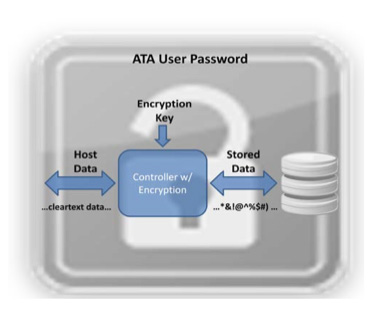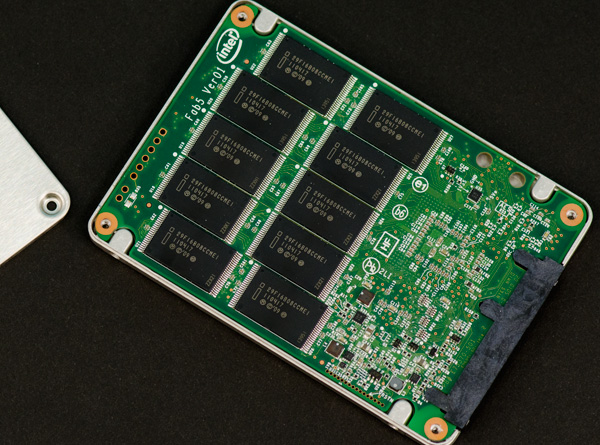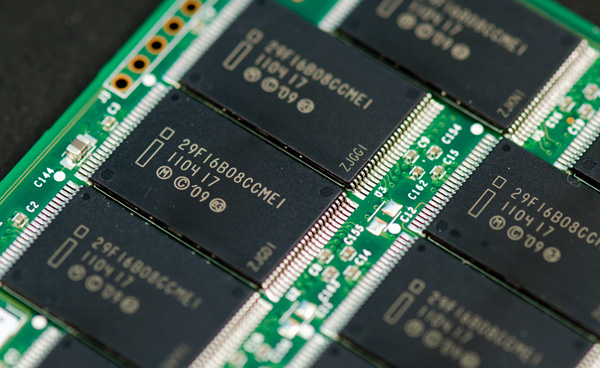The Intel SSD 320 Review: 25nm G3 is Finally Here
by Anand Lal Shimpi on March 28, 2011 11:08 AM EST- Posted in
- IT Computing
- Storage
- SSDs
- Intel
- Intel SSD 320
Spare Area and Redundant NAND
Intel's controller is a 10-channel architecture and thus drive capacities are still a little wonky compared to the competition. Thanks to 25nm NAND we now have some larger capacities to talk about: 300GB and 600GB.
Intel sent a 300GB version of the 320 for us to take a look at. Internally the drive has 20 physical NAND devices. Each NAND device is 16GB in size and features two 64Gbit 25nm 2-bit MLC NAND die. That works out to be 320GB of NAND for a drive whose rated capacity is 300GB. In Windows you'll see ~279GB of free space, which leaves 12.8% of the total NAND capacity as spare area.
Around half of that spare area is used to keep write amplification low and for wear leveling, both typical uses of spare area. The other half is for surplus NAND arrays, a RAID-like redundancy that Intel is introducing with the SSD 320.
As SandForce realized in the development of its controller, smaller geometry NAND is more prone to failure. We've seen this with the hefty reduction in rated program/erase cycles since the introduction of 50nm NAND. As a result, wear leveling algorithms are very important. With higher densities however comes the risk of huge amounts of data loss should there be a failure in a single NAND die. SandForce combats the problem by striping parity data across all of the NAND in the SSD array, allowing the recovery of up to a full NAND die should a failure take place. Intel's surplus NAND arrays work in a similar manner.
Instead of striping parity data across all NAND devices in the drive, Intel creates a RAID-4 style system. Parity bits for each write are generated and stored in the remaining half of the spare area in the SSD 320's NAND array. There's more than a full NAND die (~20GB on the 300GB drive) worth of parity data on the 320 so it can actually deal with a failure of more than a single 64Gbit (8GB) die.
Sequential Write Cap Gone, but no 6Gbps
The one thing that plagued Intel's X25-M was its limited sequential write performance. While we could make an exception for the G1, near the end of the G2's reign as most-recommended-drive the 100MB/s max sequential write speed started being a burden(especially as competing drives caught up and surpassed its random performance). The 320 fixes that by increasing rated sequential write speed to as high as 220MB/s.
You may remember that with the move to 25nm Intel also increased page size from 4KB to 8KB. On the 320, Intel gives credit to the 8KB page size as a big part of what helped it overcome its sequential write speed limitations. With twice as much data coming in per page read it's possible to have a fully page based mapping system and still increase sequential throughput.
Given that the controller hasn't changed since 2009, the 320 doesn't support 6Gbps SATA. We'll see this limitation manifest itself as a significantly reduced sequential read/write speed in the benchmark section later.
AES-128 Encryption
SandForce introduced full disk encryption starting in 2010 with its SF-1200/SF-1500 controllers. On SandForce drives all data written to NAND is stored in an encrypted form. This encryption only protects you if someone manages to desolder the NAND from your SSD and probes it directly. If you want your drive to remain for your eyes only you'll need to set an ATA password, which on PCs is forced by setting a BIOS password. Do this on a SandForce drive and try to move it to another machine and you'll be faced with an unreadable drive. Your data is already encrypted at line speed and it's only accessible via the ATA password you set.

Intel's SSD 320 enables a similar encryption engine. By default all writes the controller commits to NAND are encrypted using AES-128. The encryption process happens in realtime and doesn't pose a bottleneck to the SSD's performance.
The 320 ships with a 128-bit AES key from the factory, however a new key is randomly generated every time you secure erase the drive. To further secure the drive the BIOS/ATA password method I described above works as well.
A side effect of having all data encrypted on the NAND is that secure erases happen much quicker. You can secure erase a SF drive in under 3 seconds as the controller just throws away the encryption key and generates a new one. Intel's SSD 320 takes a bit longer but it's still very quick at roughly 30 seconds to complete a secure erase on a 300GB drive. Intel is likely also just deleting the encryption key and generating a new one. Without the encryption key, the data stored in the NAND array is meaningless.
The Test
| CPU |
Intel Core i7 965 running at 3.2GHz (Turbo & EIST Disabled) Intel Core i7 2600K running at 3.4GHz (Turbo & EIST Disabled) - for AT SB 2011, AS SSD & ATTO |
| Motherboard: |
Intel DX58SO (Intel X58) Intel H67 Motherboard |
| Chipset: |
Intel X58 + Marvell SATA 6Gbps PCIe Intel H67 |
| Chipset Drivers: |
Intel 9.1.1.1015 + Intel IMSM 8.9 Intel 9.1.1.1015 + Intel RST 10.2 |
| Memory: | Qimonda DDR3-1333 4 x 1GB (7-7-7-20) |
| Video Card: | eVGA GeForce GTX 285 |
| Video Drivers: | NVIDIA ForceWare 190.38 64-bit |
| Desktop Resolution: | 1920 x 1200 |
| OS: | Windows 7 x64 |













194 Comments
View All Comments
B3an - Monday, March 28, 2011 - link
lol @ this SSD.But most of all lol @ the price for this performance.
wumpus - Tuesday, March 29, 2011 - link
Somehow they sell chips that perform at levels AMD meets, as well as the high end. Both get large intel mark ups. Lol at the customers.Cow86 - Monday, March 28, 2011 - link
Have to agree here, I was looking forward to this drive to be decent performance at a low price....Performance is a bit less than I hoped for though, and the pricing is actually the same or higher than last gen. I'm looking to purchase an SSD in a few months (based on bulldozer, so somewhere late june probably) for a full rebuild of my pc, and I'll look at the pricing landscape then, but so far am dissapointed at the pricing of this entire new generation....wasn't 25 nm supposed to lower prices?As a sidenote, I couldn't help but take note of Crucial M4 results in the graphs here (which frankly, whilst doing great in write performance, seem a bit of a letdown in read performance compared to the C300?). Have I missed a review of that here, or is that inbound and have the results simply already been included in this review?
semo - Monday, March 28, 2011 - link
25nm nodes are more prone to errors and have a lower lifespan. This, and possibly other limitation, have necessitated workarounds that eat in to the savings due to smaller size (more reserve space, more ECC).Japan's natural disasters have also impacted global supply of flash (which hasn't been able to meet demand for a while now anyway)
ArteTetra - Monday, March 28, 2011 - link
I don't think this chips come from Japan. I think they are made in Lehi, Utah, USA.Furthermore, look at the date on those chips. It says 2008 and 2009, not 2011.
vol7ron - Monday, March 28, 2011 - link
I think Intel was using Samsung memory though. I'm not sure if these are manufactured in South Korea, or if Samsung has a plant in Japan.Griswold - Tuesday, March 29, 2011 - link
No. Do you pull that crap out of your ass before posting it?dagamer34 - Monday, March 28, 2011 - link
Sure, 25nm was supposed to lower prices, but all it demonstrates was that Intel was charging more for its drive previously anyway.Just looking at benchmarks, the OCZ Vertex 3 is gonna be the drive to beat, though it still isn't shipping to any retailers for sale yet.
Gami - Monday, March 28, 2011 - link
there's nothing to beat, if you're not ont he market for sale.Anand Lal Shimpi - Monday, March 28, 2011 - link
The m4 arrived while I was at CTIA last week so I just had enough time to run it through our suite. A full review of it and much more is coming soon :)